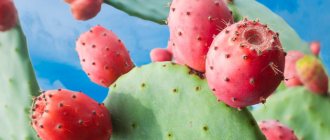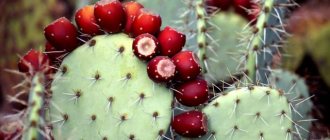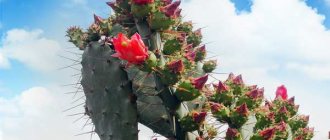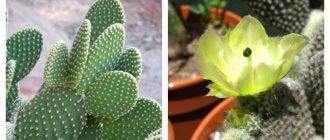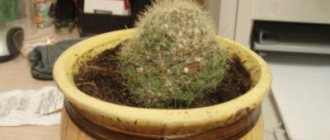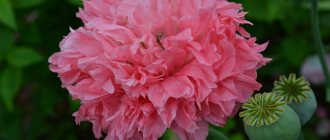The name Opuntia combines a species of plants belonging to the Cactus family. The prickly pear genus is the largest - there are more than 190 species. Many people love cacti for their unusual appearance. These plants sometimes take on very bizarre shapes. And during flowering they present an amazing sight. Large bright buds blooming on thorny shoots amaze with their beauty. Not everyone knows that prickly pear produces edible fruits that are used not only in cooking, but also in medicine and cosmetology.
Where does it grow
Cacti form a family of perennial flowering plants. They were first discovered during expeditions to North and South America, and then brought to Europe. The species of opunts is the most common. In addition to Asian countries, Africa and Australia, Opuntia grows in the Mediterranean. In our country, the plant is found on the shores of the Black Sea, in Crimea. Prickly pear adapts well to different types of climate. It prefers semi-arid habitats. The cactus can grow on dirt, sandy, rocky soils. It only does not tolerate humid tropical climates and severe frosts. It is found on all continents except Antarctica.
Contraindications and possible harm
Eating cactus fruits may come with some dangers. One of them is associated with poor-quality cleansing of the fruit from thorns. If a cactus needle gets into the digestive tract, it can injure the mucous membrane, which will lead to an inflammatory process on it and the appearance of pain. Before eating Opuntia fruits, they must be thoroughly cleaned of needles and washed well.
Another danger is associated with excessive consumption of cactus berries. This can lead to constipation and abdominal pain.
Despite all the beneficial properties, cactus fruits and stems should not be consumed if you have an individual intolerance or allergy to the product. Experts do not recommend introducing cactus berries into the diet of pregnant women due to the unpredictability of the body’s reaction to an exotic product.
What does it look like
Prickly pear is a tree-like shrub with straight or flat branches creeping along the ground. The branches look like articulated, flattened segments. The height of the stems can reach three meters. The trunk of such plants is the same as that of trees: covered with bark, with a diameter of up to 40 cm. The trunk part is short, mainly prickly pear consists of highly branching fleshy segments - cladodes, which are modified leaves. The segments are elliptical in shape and, as a rule, they are light green in color.
A distinctive feature of prickly pears is the presence of glochidia. These are sharp, hard spines equipped with teeth. They grow on the surface of reduced leaves and around the areoles - the buds of the cactus. Buds form from the buds during the flowering period. All prickly pears have flowers similar in structure and shape - large, with a large number of petals, in bright colors. The color range varies from yellow to red, violet, purple. Plants of the prickly pear species are very diverse. They can be of different shapes, sizes, shades, but they all have a similar structure.
Ferocactus Wislisen
This cactus is quite tasty and edible. The yellow fruits growing on the crown look like a miniature pineapple, but have a tougher texture and a sour taste. The fruits can be pickled in brine or stewed with sugar, after removing the seeds.
The dried seeds can be eaten by lightly roasting them to enhance the flavor or grinding them into flour.
“Coronavirus” benefits that will be canceled in the Russian Federation on April 1 have been named
Crocuses love phosphorus: how to feed them before flowering so that they will surprise you in April
Restore blood vessels after coronavirus: recommendations from a therapist
This beautiful cactus can be grown in warm regions. For best results, it is planted mainly in sandy soil. The plant requires good lighting. The cactus is easy to grow from seed indoors and transplant outdoors when it is large enough.
Fruit
After flowering, fruits form in place of the buds located along the upper edge of the segments. Their color depends on the type of cactus. It can be anything: light green, pink, orange, red, purple. Prickly pear fruits are edible. Aborigines have been eating them for a long time. In America, the common name for the fruit is “Indian fig”. Their pulp is juicy, aromatic, and tastes like berries. There is a seed pod in the center of the fruit.
They ripen between September and November. In some plant species, the berries weigh up to 300 g. The yield of prickly pears is high. From 10 sq. m you can collect up to 200 kg of berries. The fruits are collected using long sticks with a rounded knife at the end. The thorns that come across during harvesting are swept away with brushes.
Aloe
Aloe, with its long, fleshy leaves and spiky edges, is known for its medicinal properties and is also widely used in cosmetology. The gel-like interior of the leaves is used to treat eczema and also helps soothe dry skin. The plant also has an anti-inflammatory effect and accelerates the healing process of wounds.
The fate of Archil Gomiashvili’s daughter and son, who also became actors
Bob is still at the peak of fashion. Ideas for fashionable and stylish bob haircuts
They have money and power: types of men prone to cheating in relationships
Aloe with yellow flowers can be eaten. The fleshy part is edible both raw and cooked. The outer shell is bitter and contains a sticky substance. The skin needs to be cut with a knife, and the inside should be cut into pieces and washed, and then added to salads or smoothies.
Aloe feels good when grown indoors. However, in the summer you need to take the plant outside.
Varieties
In our country, cacti of this species are grown in the south in open ground, and in the middle zone - in greenhouses. Popular varieties:
- White-haired
- Berger
- Main
- Lindheimer's prickly pear
- Opuntia subulata
White-haired
This species is common in Mexico. Growing in natural conditions, the shrub can reach five meters in height. The surface of the leaves is strewn with white spines, giving the plant the appearance of hair. During flowering, beautiful yellow calyxes appear. Looks interesting in indoor flowerpots.
Berger
The plant is low, stretches up to one meter in length. This variety attracts the attention of gardeners with its unpretentiousness. Blooms with bright red buds. The leaves are thick, light green in color.
Home (main)
Plants of this species have an interesting surface color. It may be bluish or with a red tint. The flowers are pink, with large petals. Habitat is South America.
Lindheimer's prickly pear
Looks great during the flowering period - large terry buds of a sunny yellow hue bloom in abundance on the crowns of the plant. Can grow up to 3-3.5 meters. Therefore, it is recommended to plant this variety in open ground. The berries are purple in color.
Opuntia subulata
Comes from Peru. A distinctive feature of the species are the spiny shoots protruding from the trunk and branches. The flowers are pink, orange-red. This cactus looks more unusual than other prickly pears. The variety is not tall - it grows a maximum of 1 meter.
Varieties of edible cacti
Varieties of edible cacti are represented by four main types:
- prickly pear;
- Hylocereus;
- Selenicerius;
- mammillaria.
The most common type of edible cactus is the prickly pear. Not only the fruits of this plant are edible, but also the stems, leaves, and flowers (see photo). It is noteworthy that young shoots are green, and as the plant matures it acquires a red-burgundy hue. Prickly pear berries are quite small in size and densely covered with a significant number of spines. © https://ydoo.info/product/sedobnye-kaktusy.html This is why you should not take berries with unprotected hands, and they must also be peeled. The fruit tastes sweetish with slight sourness. Many people describe the taste of these berries as strawberry, others the fruits are more reminiscent of a sweet pear, and still others are sure that the cactus is close in taste to kiwi.
Another fairly popular type of edible cactus is Hylocereus, which is called “dragon fruit”. It is an interesting exotic fruit, native to Vietnam. The fruits of this edible cactus have a sour taste that is somewhat reminiscent of pitaya and strawberries. Such fruits are used to make jam, create delicacies, and use them raw as the most common fruit.
There is another variety of cacti that is edible. This is mammillaria. It is noteworthy that the fruits on this plant grow throughout the year and do not fall off. The berries have a rather sour taste. They are in demand for consumption raw, and they are also used to make jam.
One more edible cactus can be distinguished - selenicerius. But in its homeland - in the humid forests of South America - this type of cactus is often called the “queen of the night.” The main feature of this variety is its very thin roots, which resemble aerial shoots. It is thanks to them that the plant manages to obtain numerous nutritional components. This species is distinguished by large and beautiful flowers. Buds are the main decoration of a cactus. At first they are a ball of white hairs, which over time forms into a gorgeous purple flower. The latter blooms at night and fades with the first rays of the sun, hence the name “queen of the night.” The fruits are fragrant and very tasty.
Benefits and composition
Prickly pear fruits are very nutritious and healthy. You can eat not only the berries, but also the cladodes of the plant. All parts of the plant contain dietary fiber, water, starch, and glucose. Organic acids are obtained from the pulp: linoleic, stearic, palmitic. Vitamin composition:
- ascorbic acid
- a nicotinic acid
- thiamine
- riboflavin
- pyridoxine
- folic acid
- beta carotene
In addition to these substances, the plant contains calcium, magnesium, iron, and manganese. Calcium is necessary for dental health and skeletal formation. Magnesium plays an important role in the functioning of the cardiovascular system. Iron is an essential component of most body cells. It is part of red blood cells and supplies oxygen to tissues. Manganese affects the functioning of the thyroid gland and maintains blood sugar at the desired level.
Ascorbic acid is involved in the formation of bone tissue, fermentation and metabolism processes. B vitamins are elements necessary for the body to function normally. They participate in intercellular processes and affect hormonal balance. Eating prickly pear fruits and pulp has the following effects on the human body:
- supports immunity, improves hematopoiesis;
- helps cleanse blood vessels of cholesterol deposits and strengthens their walls;
- regulates blood pressure;
- stabilizes the digestive tract, improves smooth muscle motility;
- prevents the occurrence of cancer;
- calms the nervous system, eliminates insomnia and anxiety;
- improves the functioning of brain cells, strengthens memory.
Useful properties of the plant
Interestingly, Opuntia is a plant whose edible parts have a number of beneficial properties. They contain poly- and oligosaccharides, flavonoids, anthocyanins, vitamin A, C, B vitamins, galacturonic and ascorbic acids. Thanks to the substances contained in the fruits and stems of cactus, its use has:
- diuretic;
- regenerating;
- astringent;
- wound healing;
- sugar-regulating;
- lipophilic action.
Interestingly, the pulp and the cactus extract obtained from it have a lipophilic effect, which led to the use of the plant for weight loss. Scientists have found that its consumption reduces the rate of absorption of fats in the body and speeds up metabolism. In addition, the fiber contained in cactus stems improves the digestion of food and promotes regular bowel movements, which is also beneficial for weight loss.
Note: you can also use Prickly Pear vinegar to lose weight. It is prepared on the basis of 4% acetic acid and the fruits of the plant. Vinegar is used for dressing salads, preparing sauces and marinades. Its use helps reduce appetite, accelerate metabolism, and improve the functioning of the gastrointestinal tract, which leads to weight loss.
The beneficial properties of the cactus do not end there. A pronounced diuretic effect is noticeable from its use. Prickly pear in the diet helps remove excess fluid from the body and relieves swelling.
As a result of research, it was found that this plant is capable of increasing the body's tolerance to glucose. This effect of the cactus on the body allows us to recommend it as a means for the prevention of diabetes.
The benefit of cactus fruits also lies in their beneficial effect on the mucous membrane of the digestive tract. Opuntia berries promote the healing of damage to the mucous membrane, reduce inflammation, which reduces abdominal pain in people with gastritis and ulcers.
A positive effect was noticed in the treatment of prostate adenoma in men with Opuntia. Interestingly, this plant is used in Mexico to prepare a hangover remedy. Cactus juice is mixed with water and drunk in the morning after a feast.
Application
All parts of this plant are used in different fields. Flowers, cladodes, berries are used in:
- Cosmetology
- Cooking
- Agriculture
- Traditional medicine
Prickly pear flowers produce valuable oil that has anti-aging properties. It is used in the preparation of face and hair masks. It is also added to anti-aging creams. Vitamin E restores cellular structure, increases the turgor of the epidermis, nourishes and moisturizes it. This is an antioxidant that helps prolong skin youth.
Organic acids obtained from cactus pulp are used to make masks and creams for dull skin. Their use helps tighten problem areas of the face and neck and regenerates the cellular structure. Prickly pear fruit extract is added to tanning products and ointments for burns.
Cactus branches and leaves are fed to domestic animals. Thorns are removed by burning the collected parts of the plant. After heat treatment, the pulp becomes softer and more palatable. For feeding, fodder species of prickly pear are used, which are grown specifically for this purpose.
Prickly pear juice is used in folk medicine. Compresses are made from it to heal wounds and accelerate bone healing in case of fractures. These procedures also help with rheumatism and joint pain. Local residents use decoctions of dried fruits to treat vitaminosis and diseases associated with weakened immunity. Berry tincture helps against urinary tract diseases. Drinks from the flowers and roots of the plant improve the functioning of the prostate gland in men and prevent prostatitis.
Not only prickly pear berries are used in cooking, but also the pulp. Young shoots, the size of which is no more than 10 cm, are suitable for consumption. They are cut and eaten fresh or processed. Cladodes can be dried, pickled, stewed, baked. The Indians have long made various drinks using the pulp of cacti.
Prickly pear fruits have a more delicate and pleasant taste. They are eaten raw, and the following dishes are also prepared from them:
- sweet salads;
- jelly, marmalade;
- candies;
- preserves, jams;
- juice, wine, cocktails.
Description
Edible cacti are plants that belong to the cactus family.
Fruits can be included in your daily diet. Not everyone knows that the fruits of this plant are edible. For most people, cacti are spiky plants, mostly found near the computer. But there are species of this plant that are not only edible, but also very tasty. Cacti grow in South and North America, in Israel, in Tunisia, where they have long become part of the daily diet. From this article you will learn what types of cacti exist and their main features. We will also talk about the beneficial and harmful properties of such a product. The article describes in detail how to properly use edible cactus for food, as well as what can be prepared from it. In the photo you can see what edible cacti look like.
Recipes
Before starting cooking, the cladodes should be cleared of thorns and rinsed well. The berries must be peeled.
Omelette
This is a traditional Mexican dish. To prepare it you need prickly pear pulp, 2-3 chicken eggs, two tablespoons of flour, grated cheese, and spices. The prickly pear leaf must be cut so that it remains whole at the base, and the rest is strips 1 cm thick. The leaves are boiled for 20-25 minutes until soft. The eggs are broken into a cup, mixed with flour, and salted. The cactus pulp is dipped in batter and placed in a frying pan with heated olive oil. Fry on both sides, add spices. Before serving, sprinkle with grated cheese. You can eat the omelette with tomato or cream sauce.
Prickly pear salad
To prepare you will need: 2-3 prickly pear leaves, cucumber, celery stalk, canned peas. The cactus pulp is soaked in cold water for 15 minutes. Then the top layer of the peel is cut off. The leaves are cut into cubes with a side of 1 cm, brewed with boiling water for 10-15 minutes. This is necessary so that they soften and acquire a pleasant taste. Chop the cucumber and celery and place in a salad bowl. Pieces of prickly pear and peas are also added there. The salad is dressed with balsamic sauce. You can add a pinch of ground chili pepper.
Jelly
To make a beautiful jelly, you need to take prickly pear berries that are red, yellow or cherry in color. For half a kilogram of fruit, take 500 ml of water, two tablespoons of sugar, and a bag of gelatin. The berries are peeled and cut into slices. Place in a blender and blend until pureed. Gelatin is diluted with a small amount of warm water. Berry puree is poured into a pan of water and brought to a boil. Then cook over low heat for 10-15 minutes. The swollen gelatin is poured into the mixture and stirred. The mass is cooled, poured into molds, and set to freeze.
How to eat prickly pear fig or Indian fig
For preparation, fig stems are used, which in young plants have a cucumber flavor. They are added to salads, first and meat courses, and liqueurs. Marmalade, jams, and preserves are prepared from such products. In addition, they are consumed raw. Before eating prickly pear figs, you need to prepare them properly.
Pulling out needles
Already in the store, when buying fruits, you cannot pick them up with your hands. Special devices are designed for this. At home, when getting rid of needles, it is recommended to use durable, thick rubber gloves. The fruit itself must be fixed using wide tongs.
Before the procedure, it is advisable to rinse the fruit under strong water pressure.
After this, thoroughly wipe its surface using a thick cloth folded several times. In some cases, you can freeze the Prickly Pear and then simply shake off the needles. You can also use open fire to get rid of them.
You may be interested in:
How to properly cut and peel a mango with a pit - can it be eaten? Many lovers of exotic plants consider mango to be the most juicy, sweet and delicious fruit native to India.... Read more...
Peeling
The outer skin is characterized by hardness, density and great thickness, so you need to get rid of it. For this it is better to use a sharp knife.
The entire skinning process consists of three stages:
- First you need to cut off the opposite ends of the fruit.
- Make a neat longitudinal cut along the entire length.
- Take the ends of the skin on both sides, pull it back and remove the skin.
Taste of fruits
Depending on the variety, prickly pear differs in taste and aroma. Despite the fact that different fruits may be sour or sweeter, their common characteristic is juiciness and wateriness. They are enjoyed with pleasure in countries with hot or cool climates.
This product perfectly quenches thirst, so it is often used to prepare various drinks. The consistency of the pulp resembles grapes, since it contains small seeds. They can also be chewed and eaten. A unique feature of the fruit is its special sour taste. Their taste is often compared to strawberries, kiwi or pear.
Prickly Pear Recipes
The fruits, stems, and leaves of this plant are rich in taste, so they are used to prepare various dishes. Parts of prickly pear are stewed with meat, boiled, fried, pickled, baked in the oven. For cooking, young leaves are most often used, which are thoroughly cleaned of needles with a knife and washed.
The easiest way to make scrambled eggs is with prickly pear. To do this, the leafy cactus pads are crushed and then fried in a frying pan. You can use butter or vegetable oil. Then beat in two chicken eggs, add salt and sprinkle grated cheese on top.
Prickly pear dishes
To prepare marmalade, the pulp of prickly pear fruit is used, which must be crushed by rubbing through a sieve.
In this recipe you need to use the following ingredients:
- cactus puree – 400 g;
- dry salad dressing – 1 tsp;
- gelatin – 1 tsp;
- sugar substitute (stevia) - ½ tsp;
- water – 50 g.
Step by step recipe:
- Heat the pureed prickly pear pulp over low heat until boiling. At the same time, it needs to be stirred constantly.
- Dissolve gelatin in hot water. Add the solution to the pulp, bring everything to a boil.
- Add the remaining ingredients and mix thoroughly. Cool the mixture, pour into silicone molds, and place in the refrigerator.
Interesting Facts
The Mexican Indians have a legend that the ancient Aztec state of Tenochtitlan was founded on the site where a large prickly pear shrub grew. At that time, the Aztecs did not have their own settlement and wandered through the mountains. One day they saw a cactus on which an eagle was sitting, having dealt with a large snake. This was interpreted by the leader as a good sign, and the Indians decided to found a city on this place. Now there is modern Mexico City (the capital of Mexico).
The Sicilian province annually hosts a festival dedicated to prickly pear. It is celebrated in October, when the harvest has already been harvested. The village is decorated with garlands and food tents are set up. The main treat is the berries of the plant, but there are many other goodies as well. You can taste a delicious liqueur made from prickly pear fruits, try different dishes from the queen of the holiday. At the end there is a fireworks display.
Popular signs say that prickly pear in the house protects against the evil eye and attacks from ill-wishers. If the plant is placed on a windowsill or table, then sorcerers will not be able to damage the owner. And according to modern concepts, cacti neutralize electromagnetic radiation emanating from a computer, TV, etc.
There is also a sign that prickly pear in the house is a sign of divorce. The plant with its energy attracts lovers and brings relationships to disintegration. In the Middle Ages, ladies used this ability to eliminate an annoying spouse. There is also an opinion that the cactus lives well in families where scandals and quarrels are frequent.
However, you should not blindly believe in prejudices. A passion for cacti indicates an unusual nature, a love for everything extraordinary. Blooming prickly pears are a wonderful interior decoration that creates a positive mood for all household members.
Questions and answers about the prickly pear cactus
Is it true that cactus fruits give euphoria (intoxicate)?
In ancient Mexico (where prickly pear was brought from) the cactus was called peyote and was used as a ritual remedy. The bitter juice of the stem and root of peyote contains alkaloids mescaline, lophophorine, peyotine, etc., which cause auditory and visual color hallucinations.
In 1918, Dr. Louis Levin obtained a substance from peyote, which he called anhalonine. His work was continued by Geffter and Shpet, who established the alkaloids: angolonine, angalinine, peotine, lophophorine and mescaline. The latter causes temporary loss of consciousness and the appearance of colored visions, as well as musical hallucinations. According to some, when listening to music, colorful pictures appear. Nausea, dizziness and headache are also felt, eye damage and constriction of the pupils are observed.
V. E. Dixon (London) stated that with small doses the pulse slows down, but blood pressure increases. All this affects the brain and brings the body into a state of excitement and intoxication; The sensitivity of the organs of smell and hearing is also excessively aggravated. Life-threatening doses lead to complete paralysis and death.
The method for obtaining angalonine from cactus has been removed as part of the government's fight against such information on the Internet.
Use for medicinal purposes and cooking
The use of cactus fruits for medicinal purposes and cooking is very common. Often the fruit is used raw. But it is also quite often included in a variety of desserts, fruit salads and fruit drinks. The pulp is often a component of liqueurs. A variety of jams, confitures, preserves and marmalade are prepared from the fruits alone or in combination with other fruits.
Interestingly, in many countries the fruit is used to prepare meat dishes. In particular, cacti complement sauces and gravies, adding a sweet and sour flavor to them. Often, cactus fruits are stewed with meat ingredients. When prepared, the cactus tastes similar to sour pepper. But cactus leaves look more like sorrel or ordinary lettuce.
For medicinal purposes, decoctions are prepared from cactus fruits. For example, at home you can make an anti-cold decoction from cactus fruits, marshmallow root and honey. To do this, marshmallow root syrup is first prepared, and then the remaining ingredients are added to the mass. For two parts of syrup you will need one part of honey and cactus fruits.
A home remedy for fever, which is prepared from prickly pear fruits and three liters of water, is also effective. It is enough to brew the fruits in water, and then use the resulting decoction to reduce body temperature.
Diseases and pests
- The main pest of Opuntia is the Nematode worm. It settles in the roots of the cactus, lays eggs there, and the miniature worms, growing, lead to swelling in the root system. To get rid of the parasite, use water at a temperature of 45-49 degrees, in which the Opuntia roots are placed for 9-12 minutes, while the root collar should remain above the surface. After heat treatment, the swellings are cut off, the open wounds are dried and treated with crushed coal. The soil must be disinfected.
- Sucking pests in the form of mites, mealybugs, scale insects or whiteflies feed on the juice of the Opuntia by piercing micro-holes in its shell. At any stage of development, these parasites can be visually detected on the body of the cactus. Unusual bumps, small crawling insects of white, yellow or brown color are signs of damage. To quickly and effectively destroy parasites, acaricides are used, which are available in a large variety on the shelves, according to the recipes on the packages. The treatment is carried out twice, the second time to destroy the individuals hatching from the larvae. The period between treatments is from a week to 10 days.
- The main diseases of Opuntia are various types of rot: gray, wet, pythium rot; late blight fungus. Rotting of the root system occurs from regular waterlogging of the soil or excess nitrogen in the soil. Late blight develops when water stagnates in the sinuses and “wrinkles” of the stems. Conclusion: improper care leads to Opuntia disease. Recovery occurs after removing the affected areas mechanically, for example with a sharp knife, and treating with fungicides. Before planting, the soil is replaced with sterilized one.
Home care
Lighting
Under natural conditions it grows in desert and semi-desert areas, in mountains, steppes, and hillsides. All these places have abundant lighting, a lot of sun, virtually no shadow and plenty of fresh air.
It follows from this that in apartments or houses it is placed on the southern window sills, less often on the southeastern and southwestern ones. If there is a lack of light, you can’t expect flowering or active growth from Opuntia; this also undermines its health. Even in summer, during prolonged cloudy periods, the cactus is illuminated using artificial lighting for up to 14-16 hours. Before flowering begins, the plant is turned around its axis every 2 weeks, but after that, turns threaten to cause the buds to fall off.
In the spring, when the length of the sunny day increases and the dormant mode changes to the active growth phase, move the Prickly Pear to the windowsill in advance. This will naturally allow her to adapt to the changing intensity of the sun's rays and, in fact, to the duration of daylight hours. With a sudden change in lighting from artificial to natural, burns may form on the surface of the plant.
Temperature
Changes on the thermometer with the change of seasons sets the rate of growth and development of Opuntia in nature. Temperatures in summer are usually in the range of 25-35 degrees Celsius. In winter, rest is optimal at 7-10 degrees at home. In the wild, different species are accustomed to the following conditions:
- Prickly pear from central and western America feels comfortable in temperatures down to -5°C, and even snow cover is not a hindrance to them;
- Temperatures in Mexico never drop below zero degrees. Therefore, for example, frosts are contraindicated for White-haired Prickly Pear;
- in the south of America the climate is very mild and even +7 degrees is considered a cold temperature;
- For Opuntia Kamancha, temperatures down to -30 degrees are permissible!
- A representative of a region with warm winters is Creeping Opuntia.
Summer is a time when there are no special requirements for temperature, but in the autumn-winter period it is necessary to lower it. If you do not provide a period of rest, the cactus will begin to stretch, the leaves at this time will be thinner and the color will be paler. The situation can be aggravated by a lack of light, which will affect the proportions of the trunk, stems and leaves, in which case you will get an unsightly plant.
Home and Outdoor Placement
At home, most often the hottest and brightest place is chosen for Opuntia, for example, the windowsill of a south window. Nearby plants should not require high humidity or shading, as these will be diametrically opposed care conditions. Even if the temperature and amount of light are within acceptable limits, pay attention to the presence of periodic drafts, which negatively affect the health of the cactus. If Opuntia is grown in open ground, that is, in winter the temperature “overboard” is not lower than -5...-7 degrees Celsius, then during the cold period it is covered with dead wood and branches of coniferous trees. By spring, you may notice that the cactus has become a little “sagging” and has lost its elasticity - there’s nothing wrong with that, it’s just that the liquid reserves inside the stems are depleted. The most popular varieties of Opuntia suitable for growing as a garden cactus and wintering outdoors: Polycanthus, Feokantha, Imbricanta, Fragilis, Mayueniopsis.
Opuntia fragilis
Watering
Rare but plentiful rains in the area where Opuntia grows have taught it to store moisture in its body, so watering at home is carried out rarely, but in large quantities. On average, the interval between waterings is one month. The branched and strong root system quickly absorbs water entering the surrounding soil. The signal for the need to water is when the soil in the pot is completely dry. Water is poured directly onto the soil, without getting on the trunk and branches of the cactus. You can use bottom watering; to do this, place the pot with the plant for 5-10 minutes (depending on its size) in a container of water so that the water does not reach the stem. The procedure is carried out almost at sunset, at this moment the photosynthesis of Opuntia is suspended, but the root system, on the contrary, is ready to absorb nutrients and water from the ground.
Alkaline water is not allowed to get on the areoles of the plant, this leads to their enveloping in lime and subsequent death. And as you remember, the buds are the points of growth, respiration and reproduction of Opuntia.
From mid-autumn, watering is gradually reduced, as the evaporation of liquid from the ground decreases. This is facilitated by low temperatures, increased air humidity during rains, and shortened daylight hours. By the beginning of winter, they completely refuse to add water. Cacti under 1 year of age still continue to be watered, their roots are poorly developed, and the above-ground part is not yet able to store enough water to last until next spring. There are times when the trunk and branches of Opuntia begin to lose elasticity, hardness, and shape. This phenomenon is called “loss of turgor.” Due to the increased temperature, internal processes are not able to slow down enough to put the plant into “hibernation”. At such moments, water with a small amount of water, increasing the ambient air temperature to 14-18 degrees Celsius. If this is done at low temperatures, the root system will rot. According to the method described above, in the spring, healthy cacti are brought out of suspended animation (sleep).
For irrigation, you need settled tap water with a pH value of 5-6. Acidification is carried out using ordinary citric acid: a tenth of a teaspoon per liter of water.
Fertilizer
Having no leaves in the usual sense, Opuntia consumes very little energy. The area from which moisture evaporates is also small, and the root system in volume is almost equal to the above-ground part. Taken together, these factors mean that you can feed the cactus very rarely - once a month. Autumn and winter are a time for rest, and there is no need to fertilize.
Special complex mineral fertilizers are checked for the amount of nitrogen in their composition. This element is actively used by vegetable and fruit crops, but Opuntia requires it in small doses. Excess nitrogen causes rapid development of microorganisms and fungi in the soil and can lead to rotting or damage to the roots of the plant. The optimal composition would be 17% Nitrogen, 35% phosphorus, 48% potassium.
Organic fertilizer is applied to chernozem soils with fruit crops. They are not used for clay soils with Opuntia.
Soil and soil
Clayey, sandy and sub-sandy soils are most similar to the natural habitat of Opuntia. Despite the clay in the soil, it is well aerated due to the large particles in its composition. The pH reaction of the correct mixtures is 4.5-6 units. Alkaline and mineral-rich commercial mixtures for cacti are not suitable for planting; when purchasing, carefully read the labels on the packages. Here are a couple of good soil compositions for Prickly Pear:
- leaf, turf soil, clay, sand, large particles (charcoal, fine crushed stone) proportions 2:1:1:1:1;
- clay, red brick, charcoal, turf soil in equal parts.
Transfer
Performed mainly in spring or early summer, before the period of active growth, flowering and formation of branches and children. If these processes begin, the action will have to be postponed either to the fall or to next year. The frequency of replanting Opuntia depends on age: those up to three years old are transplanted into larger pots annually, those older - once every 3-4 years.
A newly acquired plant is not replanted; adaptation to new location conditions occurs within 1-1.5 months.
In addition to recommendations for frequency, it is necessary to take into account the size of the plant in each specific case; actively developing ones that quickly fill the pot with roots are replanted more often than slowly growing ones.
The roots of the cactus develop to a depth approximately equal to the height of the main stem, and can grow significantly in width, so it is better if the diameter of the pot is 2 times the height. The moment of transplantation is timed so that the next watering occurs 7-10 days after planting. The old soil does not change, only the one that falls off from the earthen lump when pulling the Opuntia out of the old pot is no longer used. When planting, the top layer of soil 1 cm thick can be removed, and small pebbles can be placed in this place: there will be virtually no contact between the base of the trunk and the soil, and during watering the likelihood of its rotting will be significantly reduced.
Be careful when transplanting, use rubber gloves that will not penetrate the cactus spines and glochidia.
Before the next watering after transplantation, you need to maintain a buffer time for the Opuntia to adapt for a week. This is necessary to dry the exposed areas of damaged roots. Even experienced gardeners cannot guarantee perfect preservation of the smallest roots of any plant during transplantation, and open areas in moist soil are highly susceptible to fungal diseases or rot. This week the cactus is placed in a shaded place to retain moisture.
How many times does a plant bear fruit in its life?
- The most fruitful of the fruit-bearing cacti is pitahaya; it begins to produce 5-6 harvests of fruits in 2-3 years of life.
- Prickly pear blooms a maximum of 3 times per season and does not always produce a large harvest after the first flowering.
- Flowering of mammillaria continues for several months in the spring with parallel formation of fruits over several months.
- Rhipsalis blooms once in late winter-early spring.
- Melocactus reaches flowering age at 6-8 years of life and can bloom several times from spring to autumn.
- Schlumbergera can bloom several times a year if kept at low temperatures.

